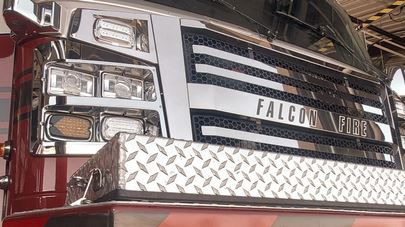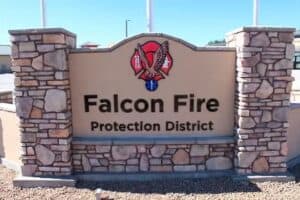By Jon Huang
Tucked behind a subdivision at the outskirts of the city and county is Falcon Fire Protection District Station No. 4.
At the door, firefighter Justin Salinas is already there to greet me. Zach Korte is behind him with a handshake of his own. Lt. Dave Hawkins, Tim Wilkerson and paramedic Jennifer Beyer complete the team.
Salinas sports a shaved head and short mustache; and, per one colleague, looks like the rapper Pitbull on steroids. He is a father of four and has worked nine years with the department. Before that, he worked in construction.
Korte worked as an EMT in California and became a firefighter in Colorado after his wife’s job brought them to the “Centennial State.” They have two children. Among his prior jobs was a stint as an elf at Bass Pro Shops. “Aren’t you a little big to be an elf?” someone interrupts. “I wasn’t in the front with all the people,” he counters.
Before the pandemic, Korte applied to an EMT position in Colorado Springs, but they were full. Falcon, which was growing its department, was hiring.
Hawkins, a 20-year veteran, explains that his role for the team is to let the junior linesman know when to rein it in and also guide their learning process.
“I serve at their pleasure,” he says.
“No, we serve at your leisure,” Salinas corrects.
Paramedic Beyer moved to Colorado about seven years ago from Indiana. The elderly there were frailer and more obese, she recalls, which made transporting patients more challenging.
Soon after breakfast, a call comes in for a patient who has fallen and cannot get up.
En route, Hawkins looks at the address. They’ve been here before. This elderly man had both knees replaced months ago; since then, he has required several EMS visits for assistance.
When we arrive, the son is waiting outside. His stress emanates like the smoke from his cigarette.
Next to the bed, the patient is on hands and knees. He was trying to get out of bed, and his legs gave out. He’s too weak to make it to outpatient physical therapy and just started home PT. He doesn’t want to go to the hospital and has declined inpatient rehabilitation in the past. After the men hoist him back onto his bed, Beyer encourages the son to advocate for increased assistance at their next doctor’s appointment.
“I’ve tried but the doctor just won’t listen!” he erupts, abruptly leaving the room.
Their daughter works in health care and will bring it up at the next appointment, the wife explains. On the way out, Beyer consoles the son.
“We’re this small speck in this giant web where everything is connected,” Hawkins says, as we discuss the complex social situations they face.
He brings up electric vehicles as an example of downstream effects. Electric vehicle fires require significantly more water than gas engines and are capable of reigniting because of how they store energy. The designers weren’t necessarily thinking about the effects this would have on us, he says.
Other cities have had issues with fires from electric batteries, and there are a couple measures being used to combat them. One is a single-use fire-suppressing blanket; another device rolls under the car to get water closer to the battery. However, not all cars are made alike, and battery location varies by model.
Much has changed in his time here, Hawkins recalls. Falcon Fire has gone from a handful of volunteers to almost 60. In the earlier days, citizens would come by to visit during the day or call the fire station to ask about what to do with an owl stuck in the barn. Now, after the pandemic, they rarely visit.
The doors used to be unlocked, and the public would come in and say hello, but then someone went upstairs at night and woke up one of the firefighters by shaking his foot.
The doors were locked soon after.
Later that morning, Salinas and Korte practice a “pump and roll.” One man drives while another walks outside with the hose. The speed of the truck controls the pressure coming out of the hose. This is used for wildland fires when brush trucks are used to flank both sides of a fire.
Next, they practice “changeovers,” a process in which the water source is transferred from the truck’s reservoir to the fire hydrant, which is often necessary when dealing with a house fire.
During a fire, Hawkins explains it’s his job to orchestrate the team’s efforts. There are different hoses on the truck, of varying lengths and diameters. Different nozzles control the water flow from the hoses, and a truck’s water reserves quickly deplete. Some hoses are offensive; they are more easily brought through doors and windows to beat back fires closer to the source. Others are defensive; they fight fires from a greater distance.
Things change by the minute, sometimes quicker. One must work efficiently, remaining mindful of resource constraints. Sometimes, the goal is to buy time to rescue civilians. Other times, it’s to save the building; sometimes, it’s preventing the fire from spreading to nearby structures.
After lunch, we head over to the Black Forest Fire station where the firefighters practice cutting padlocks and bolts, busting open doors and slicing garage doors.
Back at the station, Korte resharpens the axes while Hawkins and I clean off and dry the hoses. Salinas and Beyer spray down the trucks.
People see these machines and tools in action, Hawkins muses, but they don’t see the couple hours of cleaning, tidying and documenting after it’s all over.
“What’s the toughest part of the job for you?” I ask Wilkerson as he prepares dinner.
“Making time for the family.” He also works full time as an auto mechanic.
Many firefighters here are married, with working spouses, and children. Some work multiple jobs and take shifts at other fire departments. Some have family support. Others partner with coworkers for child care to share the load.
Over dinner, I ask the team what they want the community to know.
Beyer wishes patients understood how important it was to see their doctor before a problem occurs. Some of the tough older folks out east often refuse help and she wishes that more people took care of themselves before they developed more serious conditions. People need to learn to prevent strokes and heart attacks beyond just recognizing the signs, she adds.
Hawkins emphasizes mental health, recognizing the ways we react to stressors and how it influences behaviors. Even among first responders, the job can take a mental toll; there are those who suffer heart attacks a few hours post incident.
Some of the firefighters have used Status Code 4, an organization in Colorado Springs that provides counseling and educational resources to the first responder community. Firefighters call “code 4” when everything is under control and no further resources are needed.
Intrigued, I decide to call them up to find out more.
Next month: Huang talks to Status Code 4.





